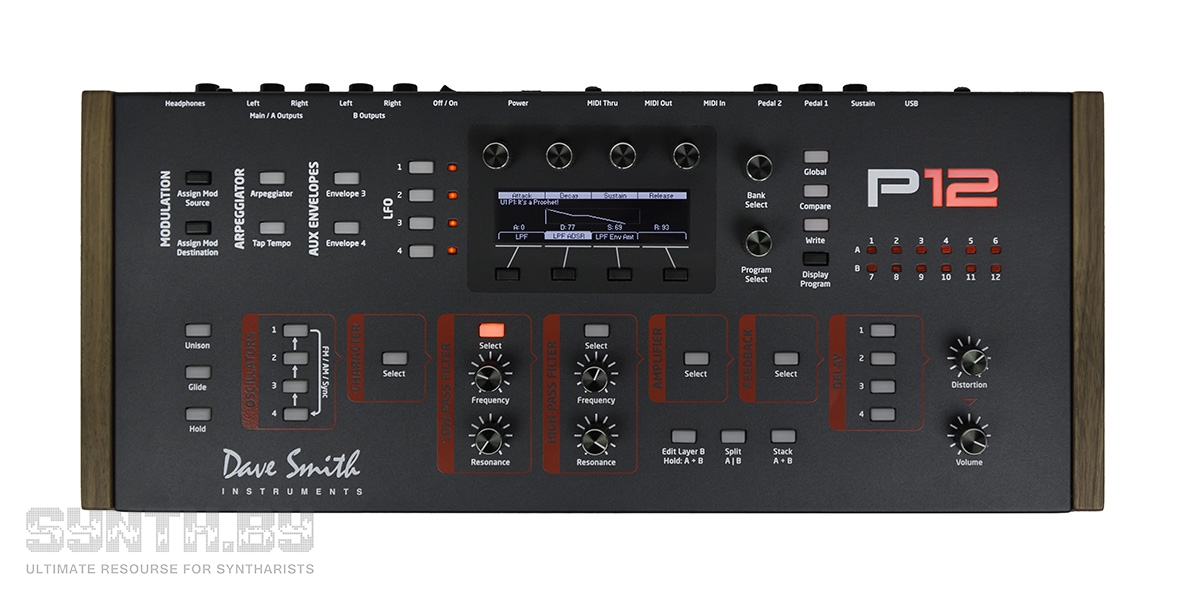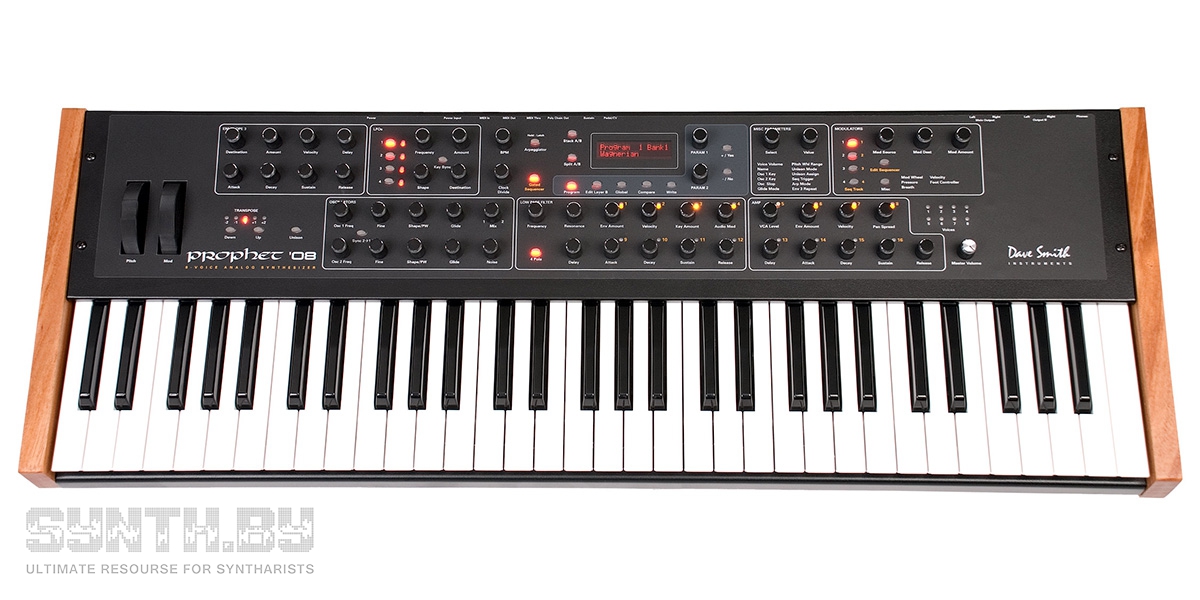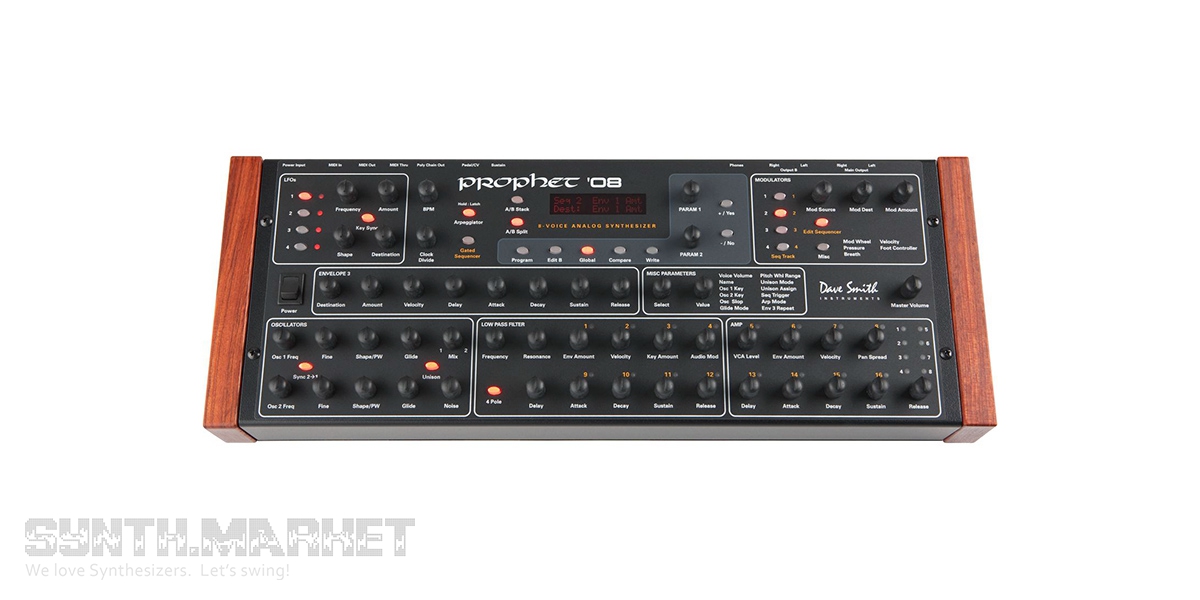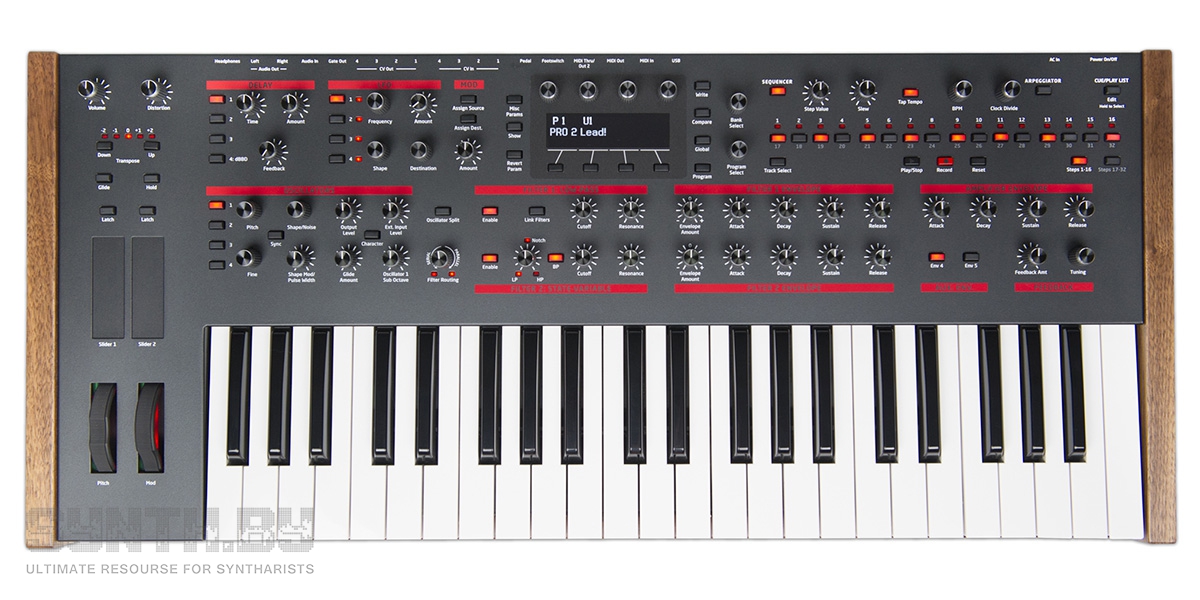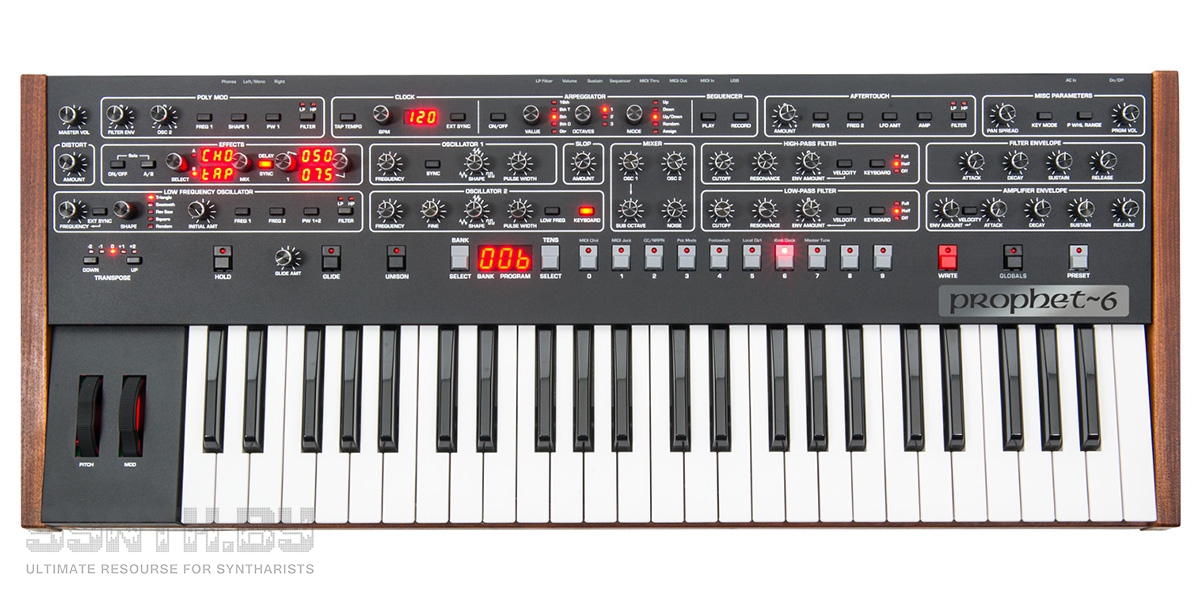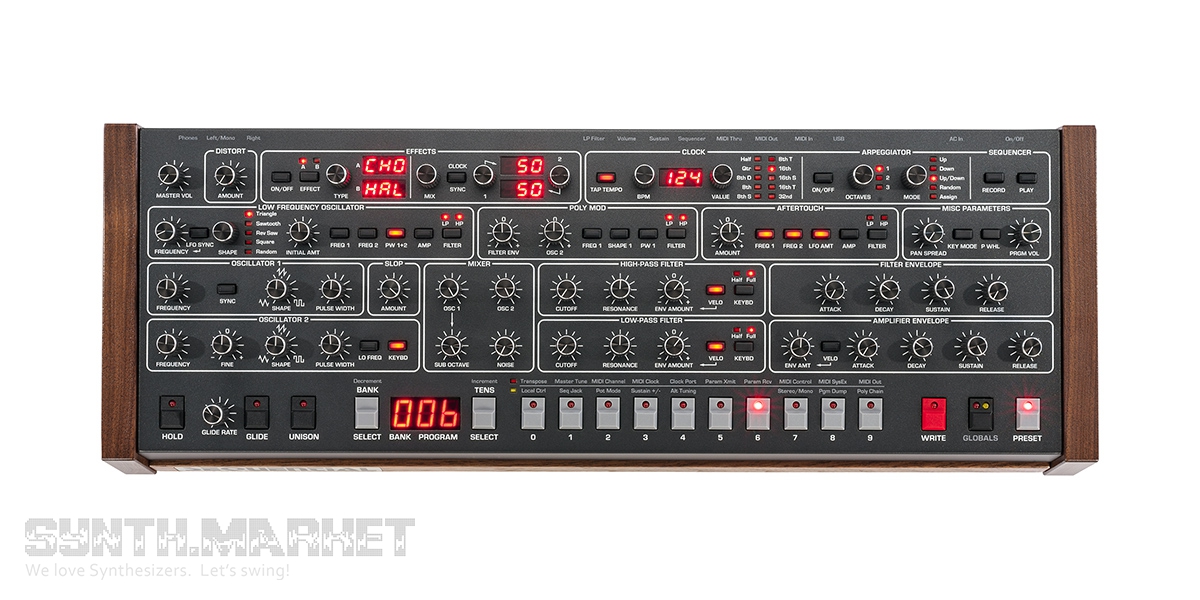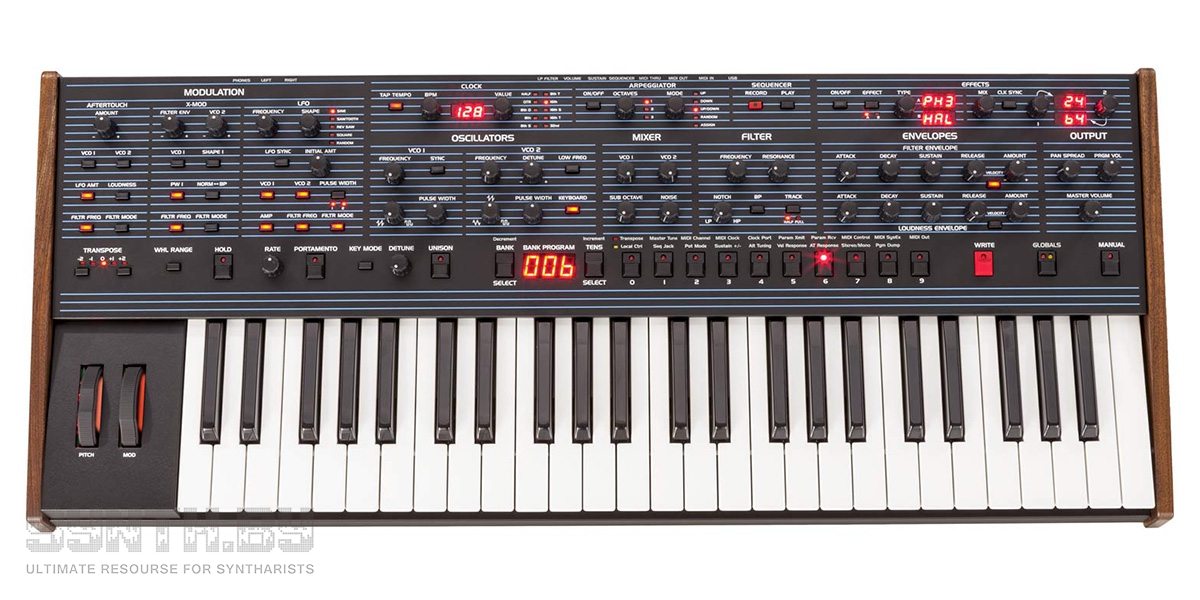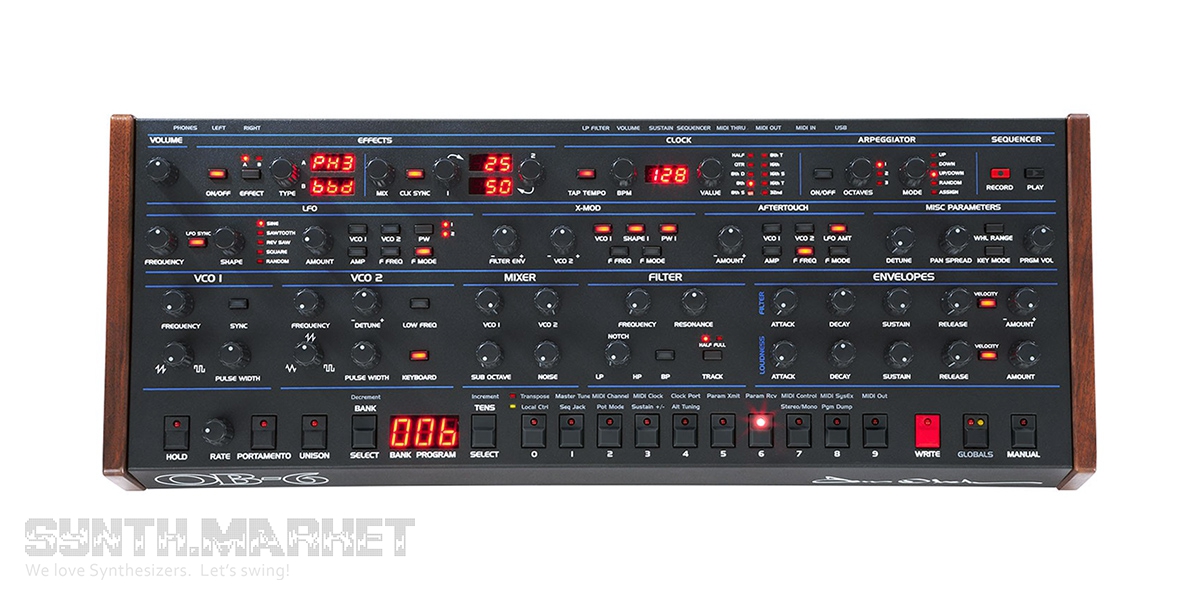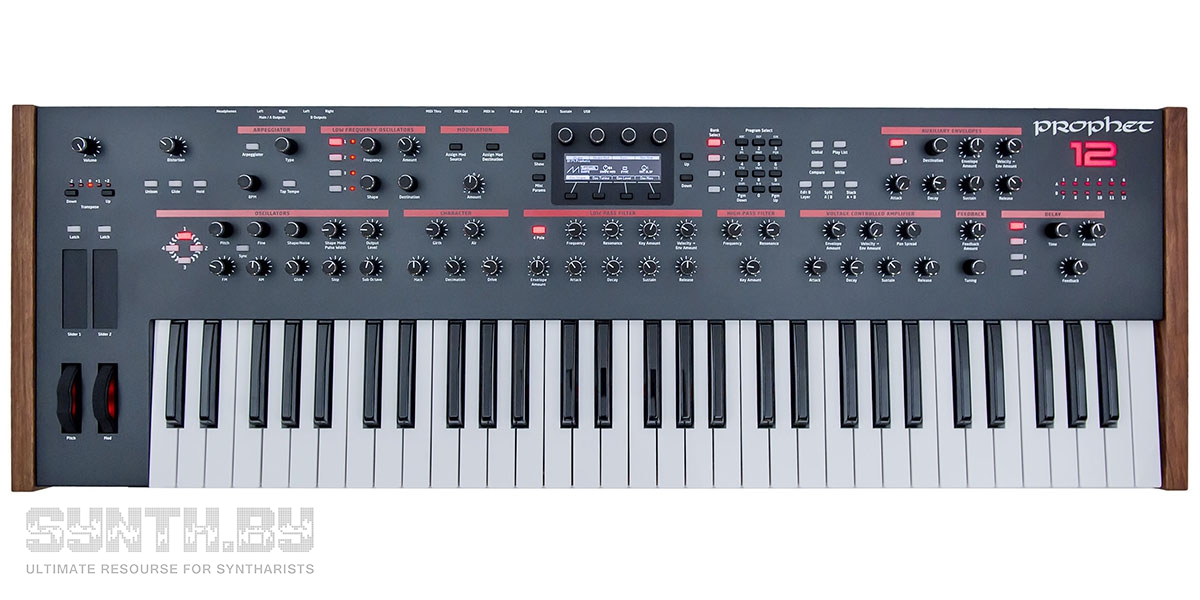 Having received Grammy for his technical achievements Dave Smith kept on constructing sound engineering artworks. Prophet 12 sporting digital oscillators but analog filters and amplifiers is the instrument any synthesis fan wants.
Having received Grammy for his technical achievements Dave Smith kept on constructing sound engineering artworks. Prophet 12 sporting digital oscillators but analog filters and amplifiers is the instrument any synthesis fan wants.
The digital section of P12 offers 4 oscillators per voice and is capable of everything. Besides 4 classic waveforms (each of which can be adjusted with a Shape Mod control giving a surprising outcome), any oscillator has 12 wavetable synthesis options and 3 noise generators (red, white and violet which Shape Mod serves as an equalizer).
The fruitful work on Prophet-VS and Korg Wavestation influenced the process of P12 creation making its digital waveforms multifunctional – each one displays “Wave Right” and “Wave Left” options and when you choose them Shape Mod control affects their harmonics producing thousands of mutations. P12 features a sub oscillator which tracks osc 1. Moreover you can make your impressive generated mix undergo frequency or amplitude modulation as well as apply the sync function in a cascading manner for all the 4 oscillators. The oscillators are open for such possibilities as glide/portamento, wave reset (so the oscillators begin running at the same point in their wave cycles) and a Slop parameter allowing you to set various pitch drift values.
Starting from Prophet 12 Smith instruments began to feature the new “Character” section including Girth and Air parameters which operation reminds of equalizing and harmonic enhancement, Decimation and Hack serving as a bitcrusher and Drive adding overdrive and saturation.
The filter bank comprises a resonant low pass 2/4-pole (based on Curtis chips adding that familiar warmth) including ADSR + key tracking filter with self-oscillation and also a 2-pole high pass filter.
Besides the standard control (together with a master analog stereo distortion parameter) a voltage controlled amplifier offers a Pan Spread option – a voice panning function.
Among the effects we should highlight the brand’s tune-able feedback circuit which can make lead sounds very expressive and an editable tempo-synced digital delay which can be modulated with envelope generators and LFO. A four-tap delay line with feedback per line will help to create interesting polyrhythmic patterns.
Besides what we’ve mentioned, P12 is enriched with rare features: 4 LFOs offer a Slew parameter – it is here to smooth the existing waveshapes, their peaks and give that distinctive voltage control “touch”, it can be applied together with “random”-modulation; 4 assignable D-ADSR envelope generators. In addition to the standard fixed routes there are 16 possible modulation routes per patch. Dave Smith considers his top synthesizer an instrument which gives practically unlimited space for creating music.
A big number of audio parameters is a significant plus as well as the audio-rate modulation. Prophet 12 offers the synthesis which can be featured only by a huge modular system and at the same time it’s suitable as a stage keyboard – the control panel of P12 offers versatile programming but it’s quite intuitive.
In 2013 Рrophet 12 Desktop Module came out. Unlike the original version sporting 59 control elements this unit offers only 12 knobs directly accessing filter and distortion sections and hiding the way to the filter envelopes and amplifier a few steps deeper which is no good for these necessary sound generating points. P12 module is easily compatible with many controllers and DAWs and features MIDI Thru.
The device emits great soundings pads, ambient textures and lead – as great as those produced by the keyboard P12 version – offering the new improved evolving presets. There are 26 modulation sources and 97 destinations available as well as the new HP/LP filter mode in the delay section.
Prophet 12 module will cost you $600 cheaper though will make you pay $50 for a SoundTower editor.
An 8-voice Prophet ’08 released in 2007 and featuring a 100% analog path sounds a bit like Poly Evolver (the filter and amplifier sections remind of those Evolver line comprised) but there are no digital oscillators. Unlike many brands which name their instruments after their commercially successful predecessors though honestly and sometimes obviously they have little in common, Prophet’08 is a true successor of the series, that same prophet – it just a new generation kind of it.
Besides the proud use of the Curtis filter the synthesizer incorporates 2 analog oscillators with digital control (DCO) per voice with sync possibility and white noise generator, 4 LFOs with a MIDI sync possibility as well. Moreover the instrument offers an analog 2/4-pole filter, analog amplifiers, 3 envelope generators (one of which is assignable), 2 banks featuring 128 fully editable programs each of which allows creating 2 layers, 4x16 sequencer and catchall modulation exploring and revealing new shades of the DSI sound.
Prophet’08 numbers 4 modulation busses with the choice of a source, destination and value – though there are some default options as well (some sources as LFO, channel pressure and etc. have their own routes: cutoff frequency, for example). The automated modulation is more representable here than in Prophet 5. 4 LFOs allows achieving bright sonorous FM-style disharmonious tones without eating up the main oscillator. The matrix can use any track of the 16-step sequencer as a mod source (or all the 4 tracks simultaneously). Each track can have its own length and each step can modulate an individual functional component and as a result we get various polyrhythms built on the phrases with an adjusted pitch, dynamic step-by-step filtration, pulse-width modulation, shaped envelope as well as thanks to the control of many other aspects.
Arpeggiator, sequencer and unison are controlled and stored independently for each layer resulting in amusing combinations – the unison offers several modes: monophonic (using 2 oscillators), “All Voices” (stacking all the available voices together) and “All Detune” (similar operation mode but here you can choose one of the 3 detune levels creating sounds from saturated to extremely intensive ones).
In order to cut that cord of endless Prophet 5 copying and simulating Dave Smith released Prophet’08 the parameters of which were coded directly by genes.
Together with the strengths it features some peculiarities which can cause some discontent making musicians doubt. There are no built-in effects and that forces us to use either the brand’s external Character Module in the Eurorack format (in this case you’ll get those P12 effects but put onto pure analog sound generated by DCO) or effect processors made by other companies. All this makes you free to choose but at the same time it adds up to the complexity of the exploitation and definitely negates portability. As always Dave Smith’s synthesizers lack sliders and pads so all the control is made via encoders or knobs with limited tweaking ability (in Prophet`08 PE version - Potentiometer Edition) which is a problem during envelopes or sequencer controlling and you have to get used to it.
Prophet ’08 Desktop almost doesn’t differ from its keyboard version carrying the same architecture, besides, it has the same number of knobs on the front panel and also lacks USB connectivity to a computer. The module can be connected to the keyboard version in order to extend the polyphony up to 16 voices.
Dave Smith Instruments Pro 2 – one of the most powerful hybrid synths in its category – occupied the mono synthesizers niche in 2014. Owing to its rich architecture, modulation and a wide range of connectivity possibilities it fit the whole Prophet 12 just in one note. The monophonic (can be also paraphonic allotting 4 oscillators to separate notes) and monotimbral Pro 2 can attract synthesis geeks as much as any workstation. And all this thanks to the elaborate architecture, built-in sequencer and wide range of connectivity possibilities.
Of course, the structure of Pro 2 differs significantly from Prophet 12 – it features the new dual analog filter, new 32-step sequencer (16 tracks), new oscillators and digital BBD sort of delay (Bucket Brigade Delay). Physically the synth offers a 4-voice paraphonic mode in which every of the 4 oscillators gets an assigned envelope allowing us to playback chords.
Pro 2 incorporates digital oscillators capable of superwave generating as well as of operating with frequency and amplitude modulation. “Character” waveform processing section offers the ability to extend the dynamic range of low and high frequencies (Boost) in order to make oscillators more expressive; it also serves as decimation/bit reduction and tube saturation emulation.
As for the filter – it includes two components: the first one re-creates a 4-pole LPF of Prophet 5; the second one is a multimode, state variable filter (SVF) copy of Oberheim’s SEM.
The modulation offers a delay section – 3 digital with panning and filter control as well as already mentioned digital bucket brigade delay (BBD) with the analog effect; 4 envelope generators with a loop function; 4 routable (to wherever) LFOs with slew and phase offset; tuned feedback; programmable analog distortion. The modulation matrix features 16 slots. The modulation of Pro 2 is valuable because of its full-featured integration with external sources: oscillators, LFO, envelope generators and sequencer tracks can be routed to the 4 CV outputs. There are 4 CV Ins, Gate out, stereo out, audio in, transmission of MIDI via USB and, of course, full MIDI implementation including MIDI Thru.
In the mono synths segment there are such loudly popular products as Arturia MicroBrute and Korg MS-20 but if you compare their keyboards it will become clear that the full-sized semi-weighted keys with channel aftertouch featured in Pro 2 are much nicer for performing. Actually, the only notable competitor in this segment is the new Arturia’s synthesizer MatrixBrute which has the same price tag Pro 2 does.
Reborn Moog company created such instruments as SUB 37, Sub Phatty, Little Phatty but they have another purpose and they represent analog synthesizers (as well as Oberheim TVS Pro). Elektron Analog Keys featuring a sequencer could be an alternative but this is a polyphonic instrument also featuring DCO. It seems that Pro 2 is truly unique and exceptional.
Prophet ’08 was considered to be the true offspring of Prophet~5 but then DSI released Prophet~6 and which is more – the instrument was given its brand name back – Dave Smith reacquired the rights to use the Sequential brand name from Yamaha (thanks to Korg as well) making all the fans go crazy and willing to have it.
The control panel reminds us of Prophet-5 with its layout. A 4-octave keyboard (velocity sensitive, aftertouch, greatly balanced for quick and accurate play) surely made the instrument more compact but upset those who considered the 5-octave Prophet-5 a perfect stage keyboard. But there’s hardly any problem about this providing that there are efficient octaves switches and you can always connect it to the MIDI keyboard. Anyway many musicians were happy with the one-function-per-knob concept thanks to which you can get rid of that time-consuming menu diving.
In the upper left part there’s a famous P5 “polymod” section which added the ability to address HP filter; it also added a “shape” parameter affecting Osc 1. A little bit lower there’s a section of the new effects and a bit to the right – a topflight distortion which turned out to be the distinctive feature of the latest instruments made by Smith.
There is only one MIDI syncable LFO (5 forms with noise generation ability) but considering the poly-mode section and the ability of Osc 2 serve as an additional LFO we should say that you won’t suffer from the scarcity of modulation sources.
Dave Smith got back to VCO, VCF and VCA. Even if stable analog oscillators falter under pressure raised by temperature ups and downs you’ll just have to press the “preset” button and hold it until the value hits “0” and the calibration starts. Moreover there’s a Slop function imitating natural oscillator drift if they seem too stable for your taste.
Unlike P5 where waveforms were fixed in circuitry, here oscillators generate continuously variable waveforms.
Prophet 6 is a true representative of the vintage analog poly synths which is just more reliable and solid thanks to the technological progress. P6 meets all the requirements in its category providing you with great leads, pads, ambient, bass and wind sounds as well as patches and unisons of solo sounds (mono-unison mode allows layering of up to 6 voices). The filter envelope generators let you create a strong and punchy bass sound. You’ll hear all the profoundness of the low-frequency range thanks to the triangle waveforms produced by a sub oscillator.
The only disadvantage of P6 is that there is no audio input and doesn’t have enough CV ins/outs. But the price is out of the blacklist – no way could Prophet 6 cost any cheaper.
Prophet~6 module version has the same structure and offers the same set of functions. The double section of the effects supplies you with studio quality reverbs, delays (including bucket brigade delay), chorus and phase shifter. While the effects are digital (24 bit 48 kHz) except stereo distortion, of course, the signal path is all analog. P6 module features 500 factory presets and memory for 500 user presets.
The latest creation of Dave Smith is the instrument made together with Tom Oberheim in 2016 and it’s called OB-6. The result of their collaboration looks like Prophet 6 with added blue stripes – one of the Oberheim trademarks. It incorporates the effects processor you’re already familiar with thanks to Prophet-6 and features the voice cards and multifilter (SVF, State Variable Filter) based on the circuitry of the SEM Oberheim’s components.
Two copies of SEM’s VCOs (Osc 1 is modulated) feature pulse-width modulation, stable tuning, and slop control renamed into “Detune” here. VCO2 can be detuned against VCO1 and that will sound more convincing and natural than it did in Prophet 6 actually. You could use an autotune if you need to get your sonic outcome “recover” from Detune.
OB-6 is definitely a powerful bass generator – as much as P6 – though while P6 is more thick, creamy and obedient enough, OB-6 emits more of a restive, acute and a bit distorted bass sound.
The filter is suitable for bright aggressive tones, drums, rampant leads, pads replete with harmonic content and growling unisons, but it’s also capable of producing beautiful soft sounds just adding some character and subtle disruptiveness. Self-oscillation is missing here anyway the filter highlights the curves and deflections of the signal path and on the whole seems to have more “personality” and identity than the filter of P6 which isn’t spineless but is surely too versatile.
A 5-mode LFO supports MIDI sync and can modulate both of the oscillators, pulse width of each one or both as well, amplifier, filter and its mode. The section of the polyphonic modulation is called X-Mod (in P6 and OB-6) and unlike the global LFO it allows modulating of each voice in order to make sound even more detailed.
It could seem that OB-6 embracing the features of P6 tried to take the best from Prophet 5 and OB-Xa/ OB-8 but nevertheless OB-6 didn’t make all the Dave’s instruments to face closure – we can compare P6 and OB-6 as long as we want but one way or another we’ll come to a conclusion that we have to purchase both – it would be perfect though – because despite the common features they appeared to be completely different.
Dave Smith Instruments was founded in 2002 in San Francisco. Each and every instrument (even budget ones) are produced and assembled in California. You won’t see a DSI unit encased in plastic – their panels are made of metal and wood. The production supervised by Dave Smith started with the Evolver line which made him hire two more colleagues in 2007 and which still brings money being commercially successful. They kept on working each in his own house – that’s how they actually created Prophet ’08. Smith has never been a hero of the past, or lazy, or nostalgic – he was focused on new designs: affordable analog Mopho series, analog polyphonic Tetra module, Tempest drum machine (in collaboration with Roger Linn) and other artworks mentioned in our review.
Now the company numbers 9 co-workers laboring in the historical center of San Francisco. These professionals know what they’re doing and where their own company’s heading for – all we want from them is to keep on going.

